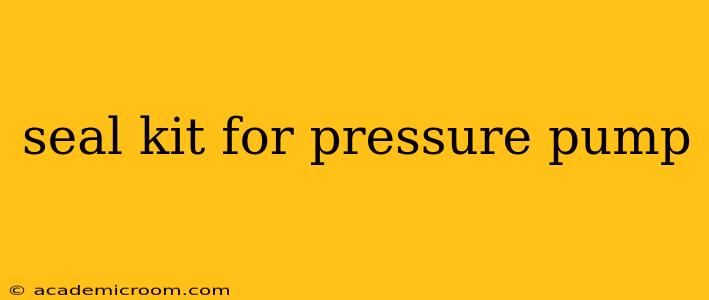Pressure pumps, vital components in numerous industries from automotive to hydraulics, rely on robust seals to maintain efficiency and prevent leaks. A failing seal can lead to significant downtime, costly repairs, and even safety hazards. Understanding seal kits and their importance is crucial for maintaining optimal pump performance. This guide delves into everything you need to know about pressure pump seal kits, ensuring you can make informed decisions about selection, installation, and maintenance.
What is a Pressure Pump Seal Kit?
A pressure pump seal kit is a collection of replacement seals designed for a specific pressure pump model. These kits typically include all the seals necessary to completely rebuild the pump's sealing system, eliminating the need to source individual components. The contents vary depending on the pump's design and application, but commonly include O-rings, shaft seals (mechanical seals), packing rings, and gaskets. Using a complete kit ensures compatibility and simplifies the repair process.
What are the Different Types of Seals Found in a Pressure Pump Seal Kit?
Several types of seals are commonly found within pressure pump seal kits:
- O-rings: These simple yet effective seals are widely used to prevent leaks between static components. Their circular shape and elasticity create a tight seal when compressed.
- Mechanical Seals: These more complex seals are used for dynamic applications, sealing the rotating shaft against the stationary housing. They are crucial in high-pressure applications and offer superior longevity compared to O-rings in such environments. They often include multiple components, such as stationary and rotating faces, springs, and elastomeric components.
- Packing Rings: Used in older or specialized pump designs, packing rings are braided or molded materials that create a seal by compressing around a shaft. They require more frequent adjustment and maintenance compared to mechanical seals.
- Gaskets: These flat seals prevent leakage between stationary parts of the pump, such as pump body flanges or covers.
What are the common causes of pressure pump seal failure?
Several factors can contribute to premature seal failure in pressure pumps:
- Wear and Tear: Over time, seals naturally wear down due to constant friction and pressure.
- Improper Installation: Incorrect installation can damage seals and compromise their sealing ability.
- Contamination: Foreign particles in the pump fluid can abrade seals, leading to leaks.
- Excessive Pressure or Temperature: Operating outside the specified pressure and temperature ranges can degrade seals and cause failure.
- Fluid Compatibility: Using an incompatible fluid can cause seals to swell, harden, or degrade, resulting in leaks.
How do I choose the right seal kit for my pressure pump?
Selecting the correct seal kit is critical. Incorrect seals can lead to pump failure and further damage. Always refer to your pump's manufacturer specifications or consult with a pump specialist. The manufacturer's part number or a detailed description of the pump (model, make, and application) will help identify the correct kit.
How often should I replace my pressure pump seal kit?
The frequency of seal kit replacement depends on several factors, including pump usage, operating conditions, and fluid type. Regular maintenance checks, including visual inspection for leaks or wear, should be performed. A preventative maintenance schedule based on hours of operation or time intervals is recommended. Some pumps might require yearly replacements, while others might operate for several years before needing new seals.
Can I repair individual seals instead of replacing the whole kit?
While it's sometimes possible to replace individual seals, it's generally recommended to use a complete seal kit. This ensures that all seals are compatible and in optimal condition, minimizing the risk of future leaks or failures. Replacing only one or two seals might still leave the system vulnerable, making it more cost-effective to replace the entire kit as a preventative measure.
Where can I find replacement pressure pump seal kits?
Seal kits are typically available from pump manufacturers, industrial supply companies, and online retailers specializing in hydraulic or pneumatic equipment.
By understanding the importance of pressure pump seal kits, selecting the appropriate kit, and adhering to a proper maintenance schedule, you can ensure the continued efficient and reliable operation of your pressure pump systems. Remember, consulting with a pump specialist can be invaluable in diagnosing issues and selecting the correct parts.
